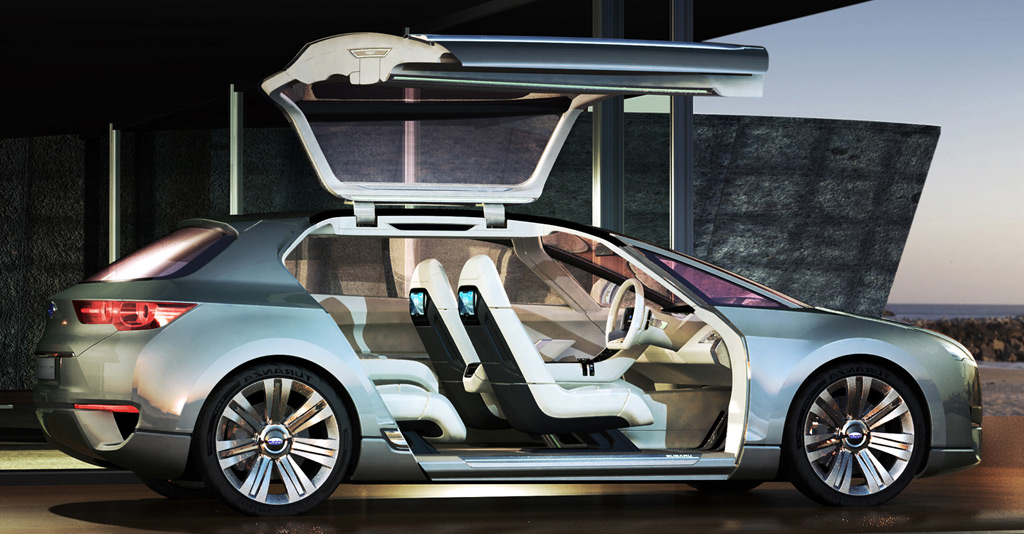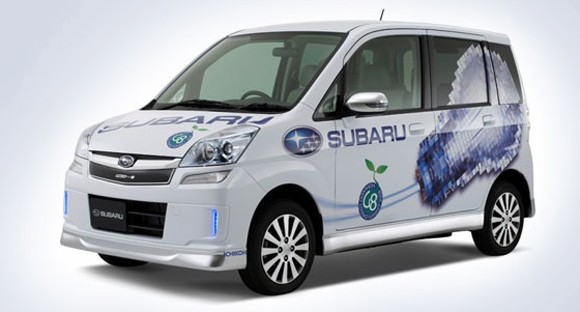Beyond the obvious Toyota, if any other make were to build hybrid cars, you might expect it to be Subaru.
The small Japanese company's cars are revered for durability and standard all-wheel drive, and their drivers are often assumed to be on the liberal side of center.
Subaru owners tend to cluster in mountainous enclaves of progressive politics, and data show their owners skew more Democratic than almost any other brand.
Now, at last, Subaru's hybrid plans are coming clear.
First hybrid in 2013
The company will launch its first hybrid vehicle in Japan within two years. That car will be a model of the Subaru Legacy mid-size sedan, most likely for the 2014 model year.
But according to a Subaru of America executive who briefed GreenCarReports on condition of anonymity, while development of the hybrid-electric drive technology is largely done, the company is still debating which vehicle will debut the hybrid system for the U.S. market.

2009 Subaru Hybrid Tourer Concept
Candidates include the popular Forester compact crossover utility vehicle, the equally popular Outback mid-size crossover, and perhaps the Legacy sedan as well.
Subaru could choose to put the system in its lowest-mileage vehicles (the larger Legacy and Outback), or increase the mileage of a more fuel efficient vehicle (the Impreza sedan or hatchback) to give the company a gas-mileage champion halo car.
Already the new 2012 Subaru Impreza will get 36 mpg on the highway, a substantial improvement over the 2011 model that gives it the highest gas mileage of any all-wheel drive car.
Mild hybrid a la Honda
The Subaru hybrid system, previewed in the Subaru B5 TPH Concept of 2005 and, at the 2009 Tokyo Motor Show, in the Subaru Hybrid Tourer concept, is a mild hybrid system very similar to Honda's Integrated Motor Assist (IMA) setup.

The General Motors eAssist system is conceptually similar, although the electric motor replaces the alternator rather than sitting between engine and transmission.
In the latest Subaru concept, a 10-kilowatt (13-horsepower) electric motor is sandwiched between a turbocharged 2.0-liter flat-four engine and the company's Lineartronic continuously variable transmission (CVT).
A lithium-ion battery pack, derived from the one used in the now-discontinued Japanese-market Stella EV electric minicar, provides power to the motor, which also recharges the battery during regenerative braking.

Subaru Stella EV
But unlike full hybrid systems like those used by Toyota, Ford, Hyundai, and others, the hybrid system is not powerful enough to propel the car on electricity alone.
Instead, it restarts the engine when the car begins to move away from a stop, and it contributes torque to supplement engine power, reducing the load on the engine and hence the fuel it consumes.
Toyota tech? Not so much
Since 2005, when Toyota purchased the share of Fuji Heavy Industries (Subaru's parent company) previously owned by General Motors, industry analysts had assumed that the small company would adopt Toyota's Hybrid Synergy Drive system--as Nissan did for its 2008-2011 Altima Hybrid, and Mazda plans to do.
But Subaru is a stubbornly independent company with a strong engineering culture. Aside from Porsche, it's the sole company offering horizontally opposed engines, which are smaller and give vehicles a lower center of gravity than inline engines.
Fitting Toyota's hybrid to a pancake engine might have posed its own challenges, but Subaru's engineers developed their hybrid system internally, along with the lithium-ion battery pack. And so the Subaru hybrid that will launch as a 2014 model will be a mild hybrid--a technology that Toyota doesn't offer.
The two companies are presently cooperating on a two-door sports coupe known as the FT-86. It will be sold as a Scion in the U.S., and the Subaru version--the brand's first rear-wheel drive car for the U.S. in almost 20 years--will be called the BRZ.
+++++++++++













